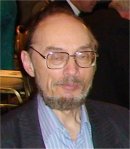
Plenary Lecture
Neoclassical Analysis as a Tool for Optimization

Professor Mark Burgin
Department of Mathematics
University of California
Los Angeles, USA
E-mail: mburgin@math.ucla.edu
Abstract: Mathematics is an efficient tool for modeling real world phenomena because mathematics reflects and studies the most fundamental level of nature, the structural level. However, in its essence, mathematics is opposite to real world because mathematics is exact, rigorous and abstract while real things and systems are imprecise, vague, and concrete. To lessen this gap, mathematicians elaborate methods that make possible to work with natural vagueness and incompleteness of information using exact mathematical structures. The most acknowledged of these approaches to this problem are fuzzy set theory, set-valued analysis, and interval analysis. Neoclassical analysis is a synthesis of these fields with the classical calculus. The aim of this synthesis is to extend the powerful technique of the classical calculus to a much broader scope, to make this technique more relevant to the situation in physics and computation.
Neoclassical analysis extends methods of classical calculus to reflect uncertainties that arise in computations and measurements. In it, ordinary structures of analysis, that is, functions, sequences, series, and operators, are studied by means of fuzzy concepts: fuzzy limits, fuzzy continuity, and fuzzy derivatives. For instance, continuous functions, which are studied in the classical analysis, become a part of the set of the fuzzy continuous functions studied in neoclassical analysis.
Aiming at representation of inexactness, vagueness, uncertainty, and imprecision by extending the scope of the classical calculus and analysis, neoclassical analysis makes, at the same time, methods of the classical calculus more precise with respect to real life applications. Consequently, new results are obtained extending and even completing classical theorems. In addition, facilities of analytical methods for various applications also become more broad and efficient.
As an example of neoclassical analysis applications, we consider fuzzy optimization in several variables with orientation at numerical methods. Although there are optimization techniques that do not use derivatives of the objective function, experts in numerical analysis advise using derivative information whenever possible. Neoclassical analysis provides such possibilities for a much wider range of objective functions than classical analysis.
Brief Biography of the Speaker: Dr. Mark Burgin received his M.A. and Ph.D. in mathematics from Moscow State University and Doctor of Science in logic and philosophy from the National Academy of Sciences of Ukraine. He was a Professor at the Institute of Education, Kiev; at International Solomon University, Kiev; at Kiev State University, Ukraine; and Director of the Assessment Laboratory in the Research Center of Science at the National Academy of Sciences of Ukraine. Currently he is working at UCLA, USA. Dr. Burgin is a member of New York Academy of Sciences and an Honorary Professor of the Aerospace Academy of Ukraine. He is a Editor-in-Chief of the international journals Integration and Information, Associate Editor of the International Journal on Computers and their Applications and International Journal of Swarm Intelligence & Evolutionary Computation, and Member of the Editorial Board of the Journal of Mathematical and Computational Science and TrippleC. Dr. Burgin is a member of the Science Advisory Committee at Science of Information Institute, Washington. He was a member of organizing and program committees of more than 50 conferences. He also organized and directed several ongoing research seminars in mathematics and computer science, such as Theoretical Computer Science (UCLA) and Foundations of Mathematics and Information Sciences (National Academy of Sciences of Ukraine). Dr. Burgin is doing research, has publications, and taught courses in various areas of mathematics, computer science, information sciences, system theory, artificial intelligence, software engineering, logic, psychology, education, social sciences, and methodology of science. He originated such theories as the mathematical theory of technology, system theory of time, general information theory, theory of named sets, hyperprobability theory and neoclassical analysis (in mathematics) and made essential contributions to such fields as foundations of mathematics, theory of algorithms, theory of knowledge, theory of intellectual activity, and complexity studies. His practical experience includes design of operating systems for supercomputers, CAD systems for electrical engineering and problem oriented languages for such systems, databases for biological information, and general expert systems, as well as mathematical modeling of databases and expert systems. Dr. Burgin has authorized and co-authorized more than 500 papers and 19 books, including “Theory of Named Sets” (2011), “Theory of Information” (2010), “Measuring Power of Algorithms, Computer Programs, and Information Automata” (2010), “Neoclassical Analysis: Calculus Closer to the Real World” (2008), “Super-recursive Algorithms” (2005), “On the Nature and Essence of Mathematics” (1998), “Intellectual Components of Creativity” (1998), “Fundamental Structures of Knowledge and Information” (1997), “Introduction to the Modern Exact Methodology of Science“ (1994), “The Structure-Nominative Analysis of Theoretical Knowledge (1992), and “The World of Theories and Power of Mind” (1992).